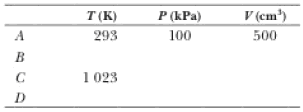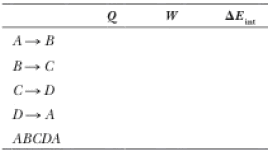
The compression ratio of an Otto cycle as shown in Figure 21.12 is VA/VB = 8.00. At the beginning A of the compression process, 500 cm3 of gas is at 100 kPa and 20.0°C. At the beginning of the adiabatic expansion, the temperature is TC = 750°C. Model the working fluid as an ideal gas with γ = 1.40. (a) Fill in this table to follow the states of the gas:

(b) Fill in this table to follow the processes:

(c) Identify the energy input |Qh|, (d) the energy exhaust |Qc|, and (e) the net output work Weng. (f) Calculate the efficiency. (g) Find the number of crankshaft revolutions per minute required for a one-cylinder engine to have an output power of 1.00 kW = 1.34 hp. Note: The
(a)
The states of the gas during the Otto cycle.
Answer to Problem 47CP
The complete table is shown below.
| State | |||
| A | 293 | 100 | 500 |
| B | 673 | 62.5 | |
| C | 1023 | 62.5 | |
| D | 445 | 152 | 500 |
Explanation of Solution
The compression ratio of an Otto cycle is
In Otto cycle, the process
Write the expression to calculate the quantity of the gas.
Here,
Substitute
In process
Write the expression to calculate the pressure at point B.
Here,
Substitute
Write the expression for the compression ratio
Substitute
Write the expression to calculate the temperature at point B.
Substitute
At state C:
Here,
Write the expression to calculate the pressure at point C.
Here,
Substitute
State D:
Here,
Therefore, the compression ratio
Write the expression to calculate the pressure at point D.
Here,
Substitute
Write the expression to calculate the temperature at point D.
Substitute
From the above explanation, the complete table is given below.
| State | |||
| A | 293 | 100 | 500 |
| B | 673 | 62.5 | |
| C | 1023 | 62.5 | |
| D | 445 | 152 | 500 |
Conclusion:
Therefore, the complete table is given below.
| State | |||
| A | 293 | 100 | 500 |
| B | 673 | 62.5 | |
| C | 1023 | 62.5 | |
| D | 445 | 152 | 500 |
(b)
The heat transferred, work done and the change in internal energy during the different process in the Otto cycle.
Answer to Problem 47CP
The complete table is shown below.
| Process | Q | ||
| 0 | -162 | 162 | |
| 149 | 0 | 149 | |
| 0 | 246 | -246 | |
| -65 | 0 | -65 | |
| 84.3 | 84.3 | 0 |
Explanation of Solution
The process
Let
Write the expression for change in internal energy in A to B process.
Substitute
Write the expression of first law of thermodynamics.
Substitute
Write the expression to calculate the energy in B to C process.
Substitute
Write the expression of first law of thermodynamics.
Substitute
Write the expression to calculate the energy in C to D process.
Substitute
Write the expression of first law of thermodynamics.
Substitute
Write the expression to calculate the energy in D to A process.
Substitute
Write the expression of first law of thermodynamics.
Substitute
Add all the work done found above to find the net work done
Add the heat energy transferred in the four process given above to find the net heat energy
The change in internal energy during a cyclic process is zero.
Thus,
From the above explanation, the complete table is given below.
| Process | Q | ||
| 0 | -162 | 162 | |
| 149 | 0 | 149 | |
| 0 | 246 | -246 | |
| -65 | 0 | -65 | |
| 84.3 | 84.3 | 0 |
Conclusion:
Therefore, the complete table
| Process | Q | ||
| 0 | -162 | 162 | |
| 149 | 0 | 149 | |
| 0 | 246 | -246 | |
| -65 | 0 | -65 | |
| 84.3 | 84.3 | 0 |
(c)
The heat input during
Answer to Problem 47CP
The heat input during
Explanation of Solution
From part (b), the heat input during
Thus, the heat input during
Conclusion:
Therefore, the heat input during
(d)
The heat exhaust during
Answer to Problem 47CP
The heat exhaust during
Explanation of Solution
From part (b)
The heat exhaust during
Thus, the heat exhaust during
Conclusion:
Therefore, the heat exhaust during
(e)
The net work output.
Answer to Problem 47CP
The net work output is
Explanation of Solution
From part (b)
The net work output is
Thus, the net work output is
Conclusion:
Therefore, the net work output is
(f)
The thermal efficiency.
Answer to Problem 47CP
The thermal efficiency is
Explanation of Solution
Write the expression to calculate the thermal efficiency.
Conclusion:
Substitute
Therefore, the thermal efficiency is
(g)
The number of crankshaft revolution per minute.
Answer to Problem 47CP
The number of crankshaft revolution per minute is
Explanation of Solution
Write the expression to calculate the output power.
Here,
Substitute
Thus, the number of crankshaft revolution per minute is
Want to see more full solutions like this?
Chapter 21 Solutions
PHYSICS:F/SCI.+ENGRS.(LL)-W/SINGLE CARD
- The stress-strain diagram for a steel alloy is given in fig. 3. Determine the modulus of elasticity (E). σ (ksi) 40 30 20 10 0 0 0.0005 0.001 0.0015 0.002 0.0025 0.0030.0035 Earrow_forwardA Van de Graff generator, if the metal sphere on the Van de Graff has a charge of 0.14 Coulombs and the person has a mass of 62 kg, how much excess charge would the person need in order to levitate at a distance 25 cm from the center of the charged metal sphere? Assume you can treat both the person and the metal sphere as point charges a distance 25 cm from each other using Coulomb's Law to calculate the electrical force. Give your answer as the number of Coulombsarrow_forwardPlease help me answer the following question. I am having trouble understanding the directions of the things the question is asking for. Please include a detailed explanation and possibly drawings of the directions of Bsource, Binduced, and Iinduced.arrow_forward
- 43. A mass må undergoes circular motion of radius R on a hori- zontal frictionless table, con- nected by a massless string through a hole in the table to a second mass m² (Fig. 5.33). If m₂ is stationary, find expres- sions for (a) the string tension and (b) the period of the circu- lar motion. m2 R m₁ FIGURE 5.33 Problem 43arrow_forwardCH 70. A block is projected up an incline at angle 0. It returns to its initial position with half its initial speed. Show that the coefficient of ki- netic friction is μk = tano.arrow_forwardPassage Problems A spiral is an ice-skating position in which the skater glides on one foot with the other foot held above hip level. It's a required element in women's singles figure-skating competition and is related to the arabesque performed in ballet. Figure 5.40 shows Canadian skater Kaetlyn Osmond executing a spiral during her medal-winning perfor- mance at the 2018 Winter Olympics in Gangneung, South Korea. 77. From the photo, you can conclude that the skater is a. executing a turn to her left. b. executing a turn to her right. c. moving in a straight line out of the page. 78. The net force on the skater a. points to her left. b. points to her right. c. is zero. 79. If the skater were to execute the same maneuver but at higher speed, the tilt evident in the photo would be a. less. b. greater. c. unchanged. FIGURE 5.40 Passage Problems 77-80 80. The tilt angle 0 that the skater's body makes with the vertical is given ap- proximately by 0 = tan¯¹(0.5). From this you can conclude…arrow_forward
- Frictionless surfarrow_forward71. A 2.1-kg mass is connected to a spring with spring constant 72 k = 150 N/m and unstretched length 18 cm. The two are mounted on a frictionless air table, with the free end of the spring attached to a frictionless pivot. The mass is set into circular mo- tion at 1.4 m/s. Find the radius of its path. cor moving at 77 km/h negotiat CH —what's the minimum icient of frictioarrow_forward12. Two forces act on a 3.1-kg mass that undergoes acceleration = 0.91 0.27 m/s². If one force is -1.2î – 2.5ĵ N, what's the other?arrow_forward
- 36. Example 5.7: You whirl a bucket of water around in a vertical circle of radius 1.22 m. What minimum speed at the top of the circle will keep the water in the bucket?arrow_forwardPassage Problems Laptop computers are equipped with accelerometers that sense when the device is dropped and then put the hard drive into a protective mode. Your computer geek friend has written a program that reads the accel- erometer and calculates the laptop's apparent weight. You're amusing yourself with this program on a long plane flight. Your laptop weighs just 5 pounds, and for a long time that's what the program reports. But then the "Fasten Seatbelt" light comes on as the plane encounters turbu- lence. Figure 4.27 shows the readings for the laptop's apparent weight over a 12-second interval that includes the start of the turbulence. 76. At the first sign of turbulence, the plane's acceleration a. is upward. b. is downward. c. is impossible to tell from the graph. 77. The plane's vertical ac- celeration has its greatest magnitude a. during interval B. b. during interval C. c. during interval D. 78. During interval C, you can conclude for certain that the plane is Apparent…arrow_forwardIf the metal sphere on the Van de Graff has a charge of 0.14 Coulombs and the person has a mass of 62 kg, how much excess charge would the person need in order to levitate at a distance 25 cm from the center of the charged metal sphere? Assume you can treat both the person and the metal sphere as point charges a distance 25 cm from each otherarrow_forward
 Physics for Scientists and EngineersPhysicsISBN:9781337553278Author:Raymond A. Serway, John W. JewettPublisher:Cengage Learning
Physics for Scientists and EngineersPhysicsISBN:9781337553278Author:Raymond A. Serway, John W. JewettPublisher:Cengage Learning Physics for Scientists and Engineers with Modern ...PhysicsISBN:9781337553292Author:Raymond A. Serway, John W. JewettPublisher:Cengage Learning
Physics for Scientists and Engineers with Modern ...PhysicsISBN:9781337553292Author:Raymond A. Serway, John W. JewettPublisher:Cengage Learning Physics for Scientists and Engineers: Foundations...PhysicsISBN:9781133939146Author:Katz, Debora M.Publisher:Cengage Learning
Physics for Scientists and Engineers: Foundations...PhysicsISBN:9781133939146Author:Katz, Debora M.Publisher:Cengage Learning Principles of Physics: A Calculus-Based TextPhysicsISBN:9781133104261Author:Raymond A. Serway, John W. JewettPublisher:Cengage Learning
Principles of Physics: A Calculus-Based TextPhysicsISBN:9781133104261Author:Raymond A. Serway, John W. JewettPublisher:Cengage Learning Physics for Scientists and Engineers, Technology ...PhysicsISBN:9781305116399Author:Raymond A. Serway, John W. JewettPublisher:Cengage Learning
Physics for Scientists and Engineers, Technology ...PhysicsISBN:9781305116399Author:Raymond A. Serway, John W. JewettPublisher:Cengage Learning





